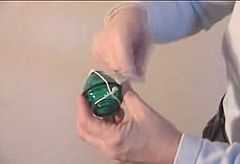Trompo

A Trompo or Whipping Top is a topwhich is spun by winding a length of string around the body, and launching it so that lands spinning on its point. If the string is attached to a stick the rotation can be maintained by whipping the side of the body. The string may also be wound around the point while the trompo is spinning in order to control its position or even lift the spinning top to another surface. [1]
Etymology
These toys are popular in Latin America where the name trompo emerged, but there are very many different local names.
Similar tops are traditional in Japan where they are known as komas. Most cities in Japan have a particular design for their koma, and the Mexican version may have been inspired by a koma.
In Spain these toys ma be called trompo or peonza or perinola or pirinola
In Germany a Peitschenkreisel may also be called Doppisch, Dildop, Pindopp, Dilledopp, Triesel or Tanzknopf (roughly dancing top)
Form
Trompos have an approximately pear-shaped body and are usually made of a hard wood such as hawthorn, oak or beech although new resins and strong plastic materials have also been used. Whipping tops often have a more cylindrical shape to provide a bigger surface to be struck by the whip.
A trofeo has a button-shaped on top, usually bigger than the tip on which trompo spins, and generally made of the same material as the rest of the body.
The base of a trompo is a stud or spike which may have a groove or roller-bearing to facilitate lifting the spinning trompo with the whip or string without imposing much friction on the body.[2]
The trompo surface may be painted or decorated, and some versions incorporate synthetic sound devices. The small size diameter and low mass of most trompos means that mechanical whistles would cause excessive drag (physics) and reduce their spinning time.
Play


Playing with a trompo consists of throwing the "trompo" and having it spin on the floor. Because of its shape, a trompo spins on its axis and swirls around its conic tip which is usually made of iron or steel. A trompo uses a string wrapped around it to get the necessary spin needed. The player must roll the cord around the trompo from the metallic tip up. The user must then tie the string in a knot on the button-shaped tip before releasing it. When rolling the cord around the trompo it must be done so that the cord is tightly attached to it. The technique for throwing a trompo varies. One end of the cord must be rolled around the player's fingers and with the same hand the trompo must be held with the metallic tip facing upwards.
Championships are held in different Latin American countries, especially in Chile, Mexico, Colombia, Peru, Cuba and Nicaragua where it is very popular among children of the middle and lower classes.
In Puerto Rico, one of the ways trompos are played is similar to playing marbles, with trompos being within a circle drawn on sand, the object being to knock them out of the circle, this can be played for keeps or otherwise. Failure to spin or spin within the circle causes your trompo to be added to it and another person has a turn to spin. Frequently, trompos in Puerto Rico and Chile are modified to have a sharper point, where in a game the object can be to split the other players trompo.
José Miguel Agrelot, a Puerto Rican comedian, hosted a long-standing television program, "Encabulla y Vuelve y Tira", whose name described the action of throwing and spinning a trompo. One of his comedic characterizations, mischievous boy Torito Fuertes, was a one-time sponsor of a line of trompos.
A trompo variation can be found in the Philippines where it is called "turumpo" or "trumpo". The Philippine version differs in the tip. The tip is straight and pointed; it usually looks like a nail embedded on a wooden spheroid. The manner of playing is basically the same except that a knot is not tied into the tip before throwing it for the spin.
See also
References
- ↑ "Wooden Whipping Top". Plimoth Plantation is a not-for-profit 501 (c)3 organization. Retrieved 25 Dec 2013.
- ↑ "Toys we grew up with". Turner Toys, Vermont USA. Retrieved 25 Dec 2013.